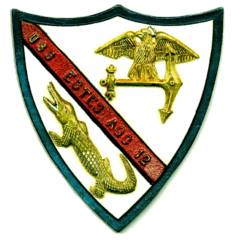
USS ESTES
AGC-12
USS ESTES ASSOCIATION
HOME PAGE
![]()
|
|
USS ESTES
AGC-12 |
|
![]()
![]()
In 1953 USS Estes participated with 11 other ships in a re-supply operation to Pt Barrow, Alaska.
|
Thanks to Tom Klaus (of the USS Electra AKA-4), we have copies of the mimeographed narrative
(called "Baked Alaska") of the Estes' 1953 cruise to Point Barrow. Some photos were
reproduced in the mimeographed document and have been scanned, but the quality
is understandably not as good as photographs: Page 1 and
Page 2. The following is verbatim from "Baked Alaska, 1953": |
|
It was June 1st when the ships of Task Force Nine began leaving California for Seattle and Alaska, although the Task Force was not officially activated until June 15th. From San Diego, Long Beach and San Francisco, ships left with special equipment aboard for the operation, which was conducted to re-supply government installations in the Far North. Twelve ships, representing the Pacific Fleet Amphibious Force, were routed via Seattle where cargo was loaded by the Army there. One Coast Guard ship and one vessel from the Military Sea Transport Service later joined the Force after leaving Seattle. The flagship, USS Estes, with Rear Admiral Frederic S. Withington, Commander Amphibious Group Three and Task Force Nine, embarked, left San Diego on July 6th for Kodiak, Alaska, arriving July 13th, seven days after the non-stop voyage began. There were eight LST's, three AKA's, one ice-breaker, one oiler, an auxiliary repair salvage ship, and an LSD, besides the communications ship that led the group. Three helicopters aboard the various ships provided short range reconnaisance of ice conditions within a 25-mile radius of the Task Force. A 17-man Underwater Demolition Team, along with beachmasters, were also included. Ice Conditions during the voyage made the trip unusual. Point Barrow's front door is the Arctic ice pack. During a brief three week period, usually from around the 25th of July to the 15th of August, the ice lanes are open, permitting navigation by ship. This was the "season" that Task Force Nine awaited. Had there been unexpected delays, it might have been too late.
During October, patches of ice begin to form on the Arctic ocean, rapidly increasing
in size until they become "pancakes." The pancakes extend and solidify into great
sheets of ice floes. The floes, pushed by the wind and pressure of the permanent
ice packs, groan, surge and buckle, throwing up peaks and projections in their midst.
Millions of tons of ice are pushed up on the beach and deposit a great pressure
ridge there--a wall of ice along the whole Arctic coast, varying in height from a
few feet to several hundred feet. Personnel assigned to the ships of Task Force Nine were officially hailed as "Blue Nose" on Sunday, July 19th when their ships crossed the Arctic Circle. Certificates issued by the Command proclaimed this for all to witness. On July 21st certain ships of the Force were anchored at Icy Cape, Alaska waiting for reports of "smooth sailing" ahead. These reports were supplied by a detachment flown earlier to Point Barrow and from the Fleet Weather Central at Kodiak, Alaska. |